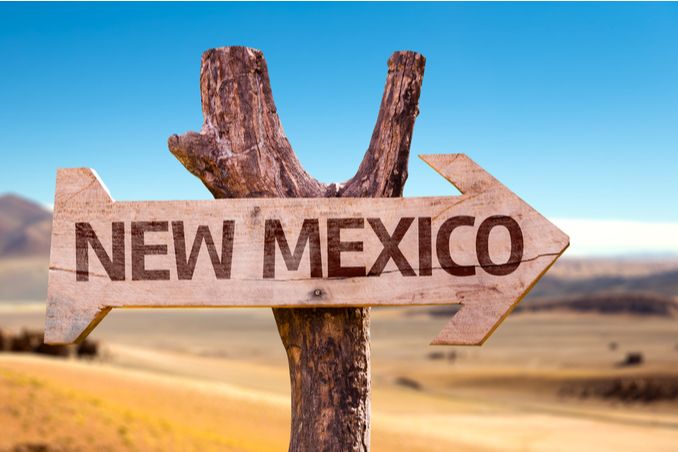Finding Addiction Treatment Centers In New Mexico
New Mexico is alive with color, scenery, culture, and cuisine, with bright Spanish colonial architecture, the immense Chihuahua Desert, and the world’s largest variety of Hatch chile peppers. Santa Fe visitors can explore the Guadalupe Mountains’ enormous limestone caverns, see any of the state’s 19 pueblos, float away in a hot air balloon, and even tickle their taste buds on a breakfast burrito tour. It’s no surprise that both native New Mexicans and visitors fall in love with this Southwestern state, but for those in need, how are the services and availability of New Mexico alcohol and drug rehab centers?
Beyond its sunset vistas and gypsum dune fields, the Land of Enchantment is home to a less appealing pastime: prescription and illicit drug misuse. Although alcoholism is a major problem in New Mexico, substance misuse is becoming much more prevalent across the state. You are not alone if drug or alcohol abuse has affected your life or the life of someone you care about.
New Mexico Drug and Addiction Facts
The most often misused drugs in New Mexico are opioid pain relievers, heroin, and methamphetamine. More than half of New Mexicans know someone who is addicted to drugs or alcohol.
In 2014, an average of seven persons died in New Mexico each week from an opioid-related overdose, which included heroin, painkillers, or a mix of the two.
Drug addiction statistics in the state of New Mexico can be quite frightening. Eighty percent of deaths in the state have been linked to the abuse of alcohol and other drugs. Currently, New Mexico ranks second highest in the entire country in the abuse of cocaine and ecstasy, and it remains fifth in methamphetamine abuse behind neighboring states such as Colorado.
According to the US Food and Drug Administration, New Mexico has the second-highest mortality rate linked to high drug overdoses, with 22.8 persons per 100,000 people dying from a drug overdose. This statistic highlights how drug abuse is badly affecting the human and economic resources of the state. The only visible form of treatment is traditional hospitals alongside New Mexico drug rehab and alcohol rehab centers.
New Mexico has one of the nation’s worst drug trafficking concerns. While small-production clandestine labs have remained in the state, drug trafficking operations (DTOs) comprise the great majority of the state’s drug supply. The majority of heroin, marijuana and methamphetamine entering New Mexico is delivered via the Mexican border in commercial vehicles; but, as a result of the state’s improved law enforcement measures, DTOs have begun smuggling their products using small-craft flights, through Texas as well as other neighbors. The steady supply of drugs has wreaked havoc on New Mexico’s communities, resulting in increasing misuse rates and the necessity for residents to seek treatment.
Substance Addiction in New Mexico: An Overview
Long-term drug rehab, outpatient therapy, and inpatient drug rehab are all options in New Mexico. Methamphetamine and opiates continue to wreak havoc on the state’s drug landscape. Find Addiction Rehabs and its skilled professionals, on the other hand, will assist you in locating New Mexico drug rehab and alcohol rehab centers. The greatest solutions for treating meth addiction or opioid addiction are short-term and long-term drug rehabilitation programs. However, no single type of drug recovery is appropriate for everyone.
There is no doubt that New Mexico has one of the most serious drug overdose problems in the nation. Since the year 1997, New Mexico has had the largest number of alcohol-related deaths in the entire country. Aside from fatal accidents and fatalities, there are other negative consequences of drug abuse in the state: crime, domestic violence, unemployment, diseases, and mental illnesses. Statistics also show that alcohol-related deaths increase with age. Individuals between the ages of 45 and 65 suffer most. Of all the ethnicities in the state, American-Indian populations are believed to have developed the highest incidence of alcohol-related deaths.

Most of the alcohol and drug rehabs in New Mexico are located in larger counties such as San Juan, Santa Fe, McKinley, Bernalillo, and Rio Ariba. Most smaller counties do not have as much access to treatment facilities. Hence, New Mexico’s rural regions have been hit the hardest when it comes to inadequate treatment for those suffering from addiction.
Many of those with substance abuse disorders in New Mexico begin to believe that they will be able to overcome their addiction on their own and that they do not require the assistance of one of New Mexico’s residential drug therapy programs. Addicts must recognize that they are genuinely dependent on narcotics for survival, or so their brain believes.
The addict has grown mentally unwell as a result of his or her continued drug usage. They actually require drugs to feel better. When the brain is denied the substances it believes it requires to survive, it reacts violently. As the drug residues drain from the addict’s body, they will experience a variety of terrible symptoms including nausea, severe headaches, and, in some cases, hallucinations. The desire to use drugs becomes too strong for the individual to ignore.
Common New Mexico Rehab, Addiction, and Substance Abuse Statistics
New Mexico’s Opioid Crisis
Despite its diverse culture and stunning landscapes, New Mexico is not immune to the opioid epidemic that is sweeping the country. Opioids, both prescription and illicit, are widely available in New Mexico. In 2016, 65 out of every 100 New Mexicans had prescriptions for opioid medicines. These narcotics are also not quiet killers; according to the Centers for Disease Control and Prevention, there were a total of 494 opioid overdose deaths in New Mexico in the same year (CDC). These statistics, while frightening, are not uncommon. However, there is hope and healing accessible for those in New Mexico battling opioid addiction.
Long-Term Drug Rehab In New Mexico
There are various long-term drug recovery programs available throughout the state of New Mexico. Substance abuse affects people of all ages and demographics in New Mexico. Cocaine and crack cocaine, marijuana, heroin, amphetamines and methamphetamines, and a range of other substances are often abused in New Mexico. According to the CDC, the state of New Mexico recorded 806 drug-related deaths in 2020, a 25.7 percent increase over the previous year. Methamphetamine use has steadily increased in the state over the last many years. Crystal meth is a dangerously addictive narcotic that is abused by people of all ages.
Methamphetamine produces an addictive euphoric high, yet the drug can cause considerable harm to the user’s mind and body. Long-term drug rehab institutions in New Mexico address crystal meth addiction on a regular basis. Many users who misuse crystal meth do it in fits and starts. There will be instances when they will heavily abuse the drug and then be sober for a long period of time.
This type of addict is tough to persuade to enter a long-term treatment program. They may easily believe they have the addiction under control while they are not consuming. The more serious side of crystal meth addiction is chronic, daily use, when users will begin to suffer the drug’s extreme bodily changes and harm to the psyche as well.
Long-term drug recovery programs can give that aid, with most facilities providing assistance 24 hours a day, seven days a week. Being accompanied by other like-minded sober people will also assist a crack-cocaine addict (or a person struggling with any addiction) in completing their treatment.
When a person undergoes detoxification and a residential drug rehabilitation program, they are removing their ability to obtain drugs when their body begins to rebel. Following the initial detoxification phase, the residential facility’s counselors will begin to work with the addict, assisting them in training their bodies to live without narcotics.
One of the most common fears that people have when considering a residential treatment program is that they will be unable to pay for the therapy. Even a short-term residential program in New Mexico can be pricey. The individual should first determine whether their insurance will cover their charges. If the addict does not have insurance that covers drug therapy, they should hunt for a facility that will accept their medical coverage instead.
Alcohol Addiction in New Mexico
The state of New Mexico has been grappling with a high incidence of alcohol-related deaths. Indeed, according to the New Mexico Department of Health, the state’s total alcohol-related mortality toll has been rated in the top ten worst in the country since 1990. The issue is still present and enduring. Many lives are lost as a result of alcohol misuse, ranging from drunk driving fatalities to organ failure caused by chronic intake. Even if prolonged usage has resulted in health concerns, it is not too late to stop abusing and save the remainder of your life.
Long-term drug and alcohol treatment programs are especially beneficial in the case of alcoholism. Starting with the first withdrawal from the substance and progressing to the counseling element to deal with the individual’s mental difficulties and challenges.
Long-term treatment is a longer program meant to provide an addict adequate time to deal with their addiction at their own speed while also reintroducing them to society as sober contributing members. With chronic alcoholism, a two-week program or a once-a-week outpatient meeting will not be enough to truly modify the addict’s lifestyle or provide the support they require to be sober.
Drug Detox Facilities In New Mexico
There are numerous drug detox centers in New Mexico, many of which are capable of detoxing addicts from very common drugs. Other circumstances may necessitate more specialized detox treatment, such as for opiate addicts who require Suboxone during the treatment process. These medications aid with withdrawal symptoms and many opiate addicts may enroll in medically assisted programs to help them stay off other opiates. Furthermore, throughout the state of New Mexico, there are medical detox institutions that specialize in assisting with the detoxification of more difficult cases. If families are unable to identify a suitable detox center, some locations offer addiction assessment services.
Treatment Options in New Mexico
New Mexico drug rehab and alcohol rehab centers typically provide a variety of treatment alternatives or interventions to properly aid you in your recovery journey:
Inpatient vs Outpatient Drug Rehabilitation In New Mexico
There are various residential and outpatient rehabilitation facilities around the state of New Mexico, many of which can provide treatment to men, women, and adolescents. Residential drug treatment clinics provide addicts with both short-term and long-term treatments. Addicts will be able to receive the correct kind of aid at these types of drug treatment centers, which use a variety of approaches to rehabilitate their clients.
Many of the same treatments can be provided by outpatient drug treatment, but these are not live-in facilities; a patient will visit daily and work through their programs. The state’s rehabilitation institutions accept health insurance, and additional payment choices include private payment, sliding-scale programs, and low-cost or free drug treatment.
Dual Diagnosis Treatment
Mental health treatments as they pertain to drug addiction have also been a challenge for the state within the past two decades. Most reported mental health disorders in the state have been linked to the prolonged abuse of drugs such as Opiates (morphine and Methadone), heroin, muscle relaxers, tranquilizers, cocaine, and anti-depressants.
Individuals treated for Bipolar disorders and depression in New Mexico have increased steadily in the last ten years, forcing health insurance companies to increase premiums on mental health disorders. People who are financially well-off enough are moving to other states to seek treatment. New Mexico is one of the country’s poorest states, and this has contributed widely to the inaccessibility of treatments in the locale. The government is fighting this problem with increased funding for Substance Abuse & Addiction IOPs.
If you have a diagnosis or co-occurring disorder (a condition in which you have both a mental health illness and a drug use problem), be sure that the treatment facility and addiction clinic you are investigating offers integrated intervention for dual diagnosis treatment. This means you should be treated for both issues at the same time.
Faith-Based Rehab
If you are a believer and want this aspect of your life to be considered in your addiction recovery, check for New Mexico drug rehab and alcohol rehab centers that offer Faith rehab approaches, as well as faith-based healing and recovery. These Faith-based treatment institutions and addiction centers assist clients in achieving recovery by providing them with Faith-based ideas.
Couples Rehab in New Mexico
For those in a relationship where both partners are drinking to excess or using drugs in unhealthy ways, a couples rehab could be just the foundation needed. By finding a facility that can treat you both at once, you stand a better chance of being aligned in your recoveries and more helpful to one another as well.
Holistic Treatment
Holistic drug rehabs in New Mexico include treatment programs that address the individual’s mind, body, emotions, and soul as well as the substance addiction problem. Acupuncture, yoga, and meditation are examples of holistic methods.
12-Step-based Treatment
The 12-step concept is based on the idea that through surrendering to a Higher power, recovered addicts can help one another attain long-term abstinence. If you are interested in this recovery technique developed by Alcoholics Anonymous supporters, you should look for drug rehabs in New Mexico that adhere to the 12-step philosophy.
Non-12-Step Treatment
If you are uncomfortable with the spiritual dimension of the 12-step approach, look for treatment clinics and addiction centers that provide a non-12 step rehab program. A non-12 step method to recovery is fully secular and rejects the notion that addiction is uncontrollable.
Should You Travel to New Mexico for Addiction Treatment?
Do you live anywhere else than New Mexico? You can still get help from New Mexico drug rehab and alcohol rehab centers. But why would you come all the way to New Mexico for treatment? Here are some of the most important reasons:
- New Mexico is a lovely state with a wonderful atmosphere, which is just what you need during the detox and treatment stages.
- Traveling out of your home state for treatment will take you away from your familiar surroundings, where drugs are conveniently obtainable. Even for those who travel all the time, like flight attendants, we recommend considering traveling for treatment.
- When you travel to New Mexico for treatment, you will be isolated from social influences and other social factors that can lead to relapse.
- If you are concerned about stigmatization when seeking treatment, traveling out of state provides you with an excellent opportunity to receive treatment in a place where no one knows you.
Traveling to another state provides you with privacy if you do not want your family, friends, colleagues, or other individuals to learn about your substance misuse problem.
Paying for Drug and Alcohol Rehabilitation in New Mexico
If the cost of rehab is preventing you from researching New Mexico alcohol and drug rehab centers, you should be aware that there are at least these seven options available to ensure you get the treatment you deserve, such as:
- Private funding and financing
- Insurance (both private and public)
- New Mexico non-profit drug rehabs
- State and local government programs
- Medicare and Medicaid
- Fundraising or crowdfunding
It is important to note that in order for any treatment program to be effective, it must be tailored to your specific needs. Don’t be frightened to choose New Mexico rehabs because you’re not sure what to expect. It’s important to remember that you’re not alone.
Drug Rehabilitation Services in New Mexico
Adult drug and alcohol treatment programs in New Mexico will include both inpatient and outpatient treatments. It is critical to call more than one sort of program while looking for a drug recovery clinic in the state.
Substance abuse problems frequently entail the use of multiple drugs, such as alcohol and prescription pharmaceuticals. Many adults and young adults in New Mexico are addicted to drugs or alcohol. When a drug problem goes untreated, the addiction worsens and it becomes more difficult to obtain help
Adult drug recovery programs run by the state as well as private drug rehab institutions are available in New Mexico. Some programs may be gender-specific, meaning they will only accept men or treat women. A substance abuse disorder does not have to be a life-long condition, and an addict can safely overcome their addiction with the correct support.
Gender-Specific Drug Rehabilitation Services in New Mexico
Men frequently use drugs and alcohol for different reasons than women, and as a result, gender-specific rehabilitation programs are available in New Mexico. In the state, a gender-specific treatment center will be an institution that solely houses men or women.
Because some male or female addicts feel more comfortable around members of the same sex, these types of treatment facilities can be highly beneficial. Some female-only drug rehab programs that may be available in New Mexico may include choices to assist pregnant women or women who have experienced emotional or physical abuse.
Addiction treatment is the greatest way to deal with it, and if an addict is unable to commit to treatment on their own, the family may have to step in. Gender-specific treatment services for men and women will be provided by the state through local addiction and mental health services, or they will be provided privately. Addiction treatment referral agencies can assist men and women battling addiction in locating the best treatment options available in their state.
Laws Of New Mexico Drug Use
Possession, sale, manufacture, or trafficking of drugs are all regarded as significant offenses in New Mexico. Violators who commit these offenses face significant punishments such as jail time, fines, or a combination of the two.
The harshness of a drug offender’s sentence in New Mexico is determined by a number of factors, including the type of drug, the amount of drug involved, and the location of the offense.
Drugs in New Mexico are categorized into five separate schedules based on the anticipated danger of addiction and the drug’s recognized use in a medical setting.
Substances on schedules I and II are thought to have the highest potential for addiction and the least amount of approved medicinal usage. Drugs on schedules III, IV, and V, on the other hand, have a lower risk of addiction while growing in medicinal value.
There are several compounds classified in each schedule, however here are a few of the more well-known examples:
- Schedule 1: Heroin and marijuana;
- Schedule 2: Cocaine and methamphetamines
- Schedule 3: Drugs containing trace amounts of lysergic acid or nalorphine;
- Schedule 4: Medications containing trace amounts of chloral hydrate or phenobarbital; and
- Schedule 5: Medications containing trace levels of specific substances, such as pseudoephedrine.
Marijuana Laws in New Mexico
Marijuana for recreational use is prohibited in New Mexico. First-time offenders found with less than one ounce of marijuana must pay a $100 fine and spend up to 15 days in jail. However, following a second infraction, the penalty is increased to a year in jail and a $1,000 fine.
If convicted of marijuana possession with the intent to sell in New Mexico, defendants risk up to 18 years in prison and a $15,000 fine.
Despite its harsh recreational marijuana prohibitions, New Mexico boasts fully functional medical marijuana regulations. The use of medical marijuana is approved to treat the following medical ailments under a law passed in 2007:
- Amyotrophic Lateral Sclerosis
- Anorexia/cachexia
- Cancer
- Arthritis
- Chronic pain
- Crohn’s disease
- Intractable nausea/vomiting
- Epilepsy
- Hepatitis C
- Glaucoma
- HIV/AIDS
- Hospice patients
- Spinal cord damage
- Huntington’s disease
- Multiple sclerosis
- Parkinson’s disease
- Painful peripheral neuropathy
- Post-traumatic Stress Disorder
Patients with a medicinal marijuana prescription can purchase up to six ounces of marijuana from a state-licensed dispensary. It is also permitted to cultivate up to 16 plants (four mature and 12 immature).
Addiction Treatment Laws In New Mexico
New Mexico, like many other states, has regulations in place to protect individuals from the potential dangers of drug use. These laws, known as harm reduction laws, cover the policies, initiatives, and resources that are available in communities to lessen the negative consequences of drug use.
Some of New Mexico’s damage reduction legislation are as follows:
- A 911 call Good Samaritan Law: New Mexico was the first state to pass a Good Samaritan Law, which permits people who are experiencing (or witnessing) an overdose to call 911 without fear of being arrested or charged for drug misuse.
- Naloxone access: The state allowed the use of Naloxone, which reverses the effects of an opioid overdose. Without a prescription, family members, friends, or other loved ones of a person at risk of an opioid overdose can receive the life-saving drug.
- Clean Syringe Access: Giving people access to clean syringes through syringe access programs (SEPs) helps minimize the spread of bloodborne infections caused by needle sharing. Most county health departments in New Mexico have these exchange programs.
Some people believe that having these services in place encourages people to take drugs more. However, harm reduction regulations seek to protect the well-being of communities by limiting the spread of diseases and the incidence of fatal opioid overdoses.
Heroin And Opioid Prevention and Education (HOPE) Initiative
Almost one out of every five New Mexicans knows someone who died as a result of an opioid-related drug overdose. In January 2015, the New Mexico Health Sciences Center and the United States Attorney’s Office established the Heroin and Opioid Prevention and Education (HOPE) Initiative in an effort to tackle the state’s high opioid-related death rates.
The HOPE Initiative is a long-term solution to New Mexico’s heroin and opiate usage problems. It promotes the development of preventive measures to educate communities about the hazards of heroin and opiate medication addiction.
The initiative’s goals are to safeguard New Mexico’s communities from the hazards of heroin and opiate painkillers. HOPE is made up of five components:
- Strategic Planning
- Prevention and education
- Law enforcement
- Treatment options
- Re-entry
More offenders have been convicted of drug trafficking since the inception of HOPE in New Mexico, and more people have sought treatment.
New Mexico Pseudoephedrine Restrictions
Pseudoephedrine is an OTC medicine that is used to treat colds and sinus congestion. It is also the main ingredient in the manufacture of methamphetamine.
New Mexico is one of many states that have daily and monthly limitations on how much pseudoephedrine a person can buy.
A person cannot purchase more than 3.6 grams of pseudoephedrine every day, and no more than nine grams in a 30-day period, according to state law. According to research, limiting the amount of pseudoephedrine a person can buy has drastically reduced the number of operational methamphetamine labs over time.
Southwest Border High-Intensity Drug Trafficking (HIDTA) Region
New Mexico is one of five states in the federal High-Intensity Drug Trafficking Area (HIDTA) program’s Southwest border region, which strives to boost drug control efforts among local, state, and federal law enforcement agencies.
Law enforcement and government officials collaborate closely, exchanging intelligence on regional drug patterns that could lead to victory in the fight against drug trafficking. So far, the initiative has assisted in the seizure of thousands of pounds of smuggled substances such as methamphetamine, heroin, and cocaine.
Choosing Addiction Treatment Centers In New Mexico
When you or a loved one decides to seek addiction treatment, the next step is to find the best rehab.
New Mexico drug rehab and alcohol rehab centers feature a variety of treatment alternatives geared to address the many stages of addiction as well as a person’s unique needs. Treatment options in New Mexico include:
- 30-day, 60-day, to 90-day residential inpatient treatment option;
- intensive outpatient rehab; and
- medical detox.
- Rehab support groups.
When assessing your alternatives, keep in mind that you deserve the best treatment for your type of addiction. Each recovery clinic is unique; however, the following questions might help assess whether their program is a good fit for you:
- Is medical detox available as part of the residential treatment program?
- Are therapy programs adapted to each individual?
- What is the treatment facility’s environment like?
- Do you provide financing or accept insurance?
- Do patients receive follow-up care after they finish treatment?
Another factor to consider is where you will receive therapy. Many folks simply select a center that is at a handy location for them. However, limiting your selections to what is closest to home may prevent you from receiving the specific therapy you require for your circumstance. This is why more people are opting to seek treatment outside of their home state.
A Pair of Excellent Options for Rehab in NM
While there are several other options for treatment across the Land of Enchantment, the offerings at a pair of facilities stand out from recent clients’ reviews, as well as on ongoing commitment to excellence in care.
- Icarus Behavioral Health: With locations in Albuquerque and Rio Rancho, and more locations in the works, the staff and clinical team at Icarus Behavioral Health have established themselves as a premier resource for those seeking treatment in the state. Crucially, they also offer mental health rehab programs, trauma treatment tracks, and a full spectrum of options to help those struggling.
- Santa Fe Recovery Center: A well-established facility in the northern part of the state, the Santa Fe Recovery Center provides an array of options to help with substance use, dual diagnosis, and more. They offer culturally informed healing and have helped hundreds of clients recover in over eighteen years in business.
New Mexico Regulations for Addiction Treatment
Alcohol and drug addiction treatment facilities in the United States are subject to stringent restrictions. Certain types of treatment clinics are required to maintain staff-to-client ratios. Counselors in New Mexico drug rehab and alcohol centers, in particular, must have a master’s degree or higher-level education in counseling or a related field in order to be licensed.
Individuals with degrees outside of the counseling profession may be asked to do additional clinical hours to demonstrate their credentials and abilities. There is also an examination process and 3,000 hours of supervised practice as a mental health counselor requirement.
Statewide initiatives monitor narcotics prescribing procedures and provide resources for people to dispose of surplus prescription medicines, but such programs are not required. As a result, whether or not to dispose of leftover prescriptions is entirely up to the individual.
Keeping these drugs on hand increases not only the potential of theft but also the chance of misuse by the people for whom they were originally prescribed. Many people are unaware that consuming a prescription drug, especially one that has been written out to you, for any cause other than the intended one is still considered drug abuse.
- New Mexico Drug & Alcohol Hotlines
On any of these hotlines, caring specialists are available to listen 24 hours a day, seven days a week.
- SAMHSA Treatment Helpline
If you are suffering from a substance use issue, the SAMHSA Treatment Referral Helpline can assist you in locating appropriate resources. You can reach them on 1.800.662.4357
- Poison Control
This hotline can answer queries about medications and drug-related poisonings as well as handle emergencies. Contact them on 800.222.1222
Call 911 for immediate assistance if you are in a drug or alcohol-related emergency.
How to Choose New Mexico Alcohol and Drug Rehab Centers
New Mexico’s drug addiction problem has received national attention dating as far back as 2007. The flow of illicit drugs into the region from neighboring Mexico has made it even more difficult for the government to manage the issues in its state.
In conjunction with several treatment facilities and centers across its counties and rural areas, New Mexico’s government has continuously beefed up its border patrol system, trying to ensure that drug routes are continually destroyed. In the same vein, special security forces have continued to step up the arrest and prosecution of drug dealers, especially along the Mexican border.
The state of New Mexico is believed to have one of the most extensive budget allocations for health and human services, primarily covering drug addiction and mental disorders. The state has also increased its funding for rehab centers and is proactive in setting up new facilities, specifically in rural areas where accessing drug addiction treatments has been difficult.
If you are looking for drug and alcohol treatment in New Mexico, there are numerous variables to consider while selecting a facility. Substance abuse treatment programs may involve a mix of intensive inpatient, partial hospitalization, and outpatient drug rehab.
New Mexico has a variety of programs available, some of which may involve aftercare and sober living housing. Simply call our hotline now to find out if an in-state option forms the best choice, and what your insurance benefits will cover for addiction treatment in New Mexico (or anywhere in the United States).
Find the Right Rehab for You in New Mexico
Inpatient drug rehab may be the ideal option for those suffering from severe addiction or who are just getting started on their recovery journey. New Mexico provides a number of residential programs, as well as outpatient programs for people who have already completed more intensive levels of rehabilitation.
While New Mexico has an assortment of rehab programs, you may want to explore a program outside of your home state. If you’re struggling with alcohol and drug addiction and you’re not sure where to turn for help, Find Addiction Rehabs provides you with all of the resources you need to locate the finest alcohol rehab center for you or a loved one based on location, cost, amenities, and treatment options. Please don’t hesitate to reach out to our dedicated team of recovery representatives any time of day or night for assistance, the time to call is now!






